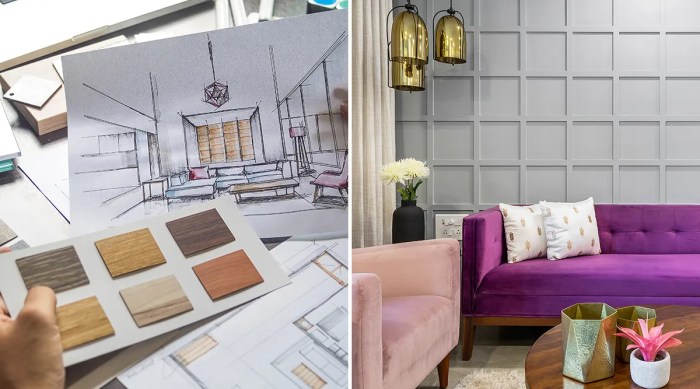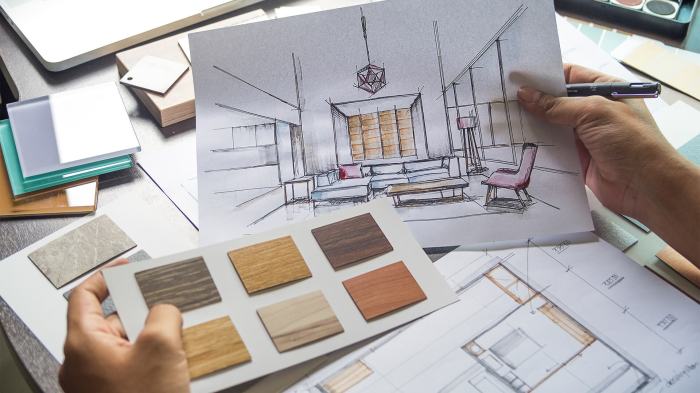As architect and interior designer take center stage, this opening passage beckons readers into a world crafted with good knowledge, ensuring a reading experience that is both absorbing and distinctly original. Whether it's the intricate process of designing a structure or the art of transforming a space, the collaboration between architects and interior designers unveils a realm where creativity and functionality intertwine seamlessly.
Overview of an Architect and Interior Designer
An architect is responsible for designing and planning the overall structure of a building. They work closely with clients to understand their needs and preferences, create detailed drawings and blueprints, and ensure that the building meets safety and regulatory standards.
Architects also oversee the construction process to ensure that the design is executed correctly.Interior designers, on the other hand, focus on the aesthetic and functional aspects of the interior spaces within a building. They work with clients to select colors, furniture, lighting, and decor that will enhance the overall design of a space.
Interior designers also consider factors such as traffic flow, accessibility, and comfort when creating their designs.
Collaboration between Architects and Interior Designers
When working on a project together, architects and interior designers collaborate to create cohesive designs that seamlessly integrate the exterior and interior of a building. Architects provide the structural framework and layout of the building, while interior designers enhance the space with their expertise in colors, materials, and furnishings.
This collaboration ensures that the overall design is not only aesthetically pleasing but also functional and practical for the occupants.
Education and Training
Becoming an architect or interior designer requires a specific educational path and training. Let's delve into the details.
Architect Educational Path
To become an architect, individuals typically need to complete a Bachelor's degree in architecture, which usually takes about 5 years to complete. This degree program covers a range of topics such as architectural history, design principles, building structures, and construction materials.
After obtaining a Bachelor's degree, aspiring architects often pursue a Master's degree in architecture for further specialization.
Interior Designer Qualifications
Interior designers are required to have a Bachelor's degree in interior design or a related field. This degree program typically includes coursework in interior design principles, spatial planning, color theory, and furniture design. In addition to formal education, interior designers may also need to obtain certifications such as the National Council for Interior Design Qualification (NCIDQ) certification to practice professionally.
Coursework and Skill Sets Comparison
During their training, architects focus more on architectural theory, building systems, and structural design. They learn how to create functional and aesthetically pleasing buildings while considering safety regulations and environmental sustainability. On the other hand, interior designers concentrate on interior spaces, furniture layouts, color schemes, and material selection to enhance the functionality and visual appeal of indoor environments.
Both professions require strong creativity, problem-solving skills, and the ability to work collaboratively with clients and other professionals in the industry.
Design Process and Methodologies
In the field of architecture and interior design, professionals follow specific processes and methodologies to create functional and aesthetically pleasing spaces.
Architectural Design Process
The design process followed by architects typically involves the following steps:
- Programming: Understanding the client's needs and requirements for the project.
- Schematic Design: Developing initial sketches and concepts to explore different design options.
- Design Development: Refining the chosen concept and developing detailed drawings and plans.
- Construction Documents: Creating technical drawings and specifications for construction.
- Bidding and Negotiation: Obtaining cost estimates from contractors and selecting a builder.
- Construction Administration: Overseeing the construction process to ensure the design is implemented correctly.
Interior Design Methodologies
Interior designers use various methodologies to transform a space into a functional and visually appealing environment:
- Space Planning: Analyzing the layout and flow of a space to optimize functionality.
- Concept Development: Creating a design concept based on the client's preferences and requirements.
- Material Selection: Choosing appropriate materials, finishes, and furnishings to enhance the design.
- Lighting Design: Planning and implementing lighting solutions to enhance the ambiance of the space.
- Color Schemes: Selecting color palettes that complement the overall design and create a cohesive look.
- Finishing Touches: Adding decorative elements and accessories to complete the design.
Comparison of Design Approaches
Architects focus on the overall structure and layout of a building, ensuring that it meets functional and safety requirements, while interior designers concentrate on enhancing the interior spaces to create a specific atmosphere or style. Both professionals work together to create spaces that are not only visually appealing but also practical and conducive to the needs of the occupants.
Tools and Technologies
Architects and interior designers rely on a variety of tools and technologies to bring their designs to life and communicate their ideas effectively.
Essential Tools and Software for Architects:
- Computer-Aided Design (CAD) software such as AutoCAD and Revit for drafting and creating precise architectural drawings.
- Building Information Modeling (BIM) software for 3D modeling and coordination of building elements.
- Graphic design software like Adobe Creative Suite for visual presentations and rendering.
- Model making tools such as 3D printers and laser cutters to create physical models.
- Measuring tools like laser measures and scales for accurate measurements on-site.
Technologies for Interior Designers:
- Virtual Reality (VR) and Augmented Reality (AR) applications for immersive design experiences and client presentations.
- Interior design software like SketchUp and 3ds Max for creating 3D models and renderings.
- Color matching tools and software for selecting the perfect color palette for a space.
- Lighting design software to simulate various lighting scenarios and effects in a room.
- Online project management tools for collaboration and project organization.
Advancements in Technology for Architects and Interior Designers:
Advancements in technology have revolutionized the way architects and interior designers work, allowing for more efficient design processes, better collaboration with clients and professionals, and enhanced visualization of design concepts. With the use of virtual reality, augmented reality, and advanced software tools, architects and interior designers can now create realistic 3D models, walkthroughs, and interactive presentations that help clients better understand and visualize the final design outcome.
Project Examples

In the world of architecture and interior design, there are numerous iconic projects that have left a lasting impact on the industry. These projects showcase the creativity, innovation, and skill of the architects and interior designers behind them. Let's explore some of these renowned projects and the sustainable practices incorporated into their designs.
Iconic Architectural Projects and Architects
- The Guggenheim Museum in Bilbao, Spain - Designed by Frank Gehry, this iconic building is known for its unique and futuristic design that has become a symbol of modern architecture.
- The Sydney Opera House in Australia - Designed by Jørn Utzon, this masterpiece of architecture is recognized worldwide for its innovative sail-like design and contribution to the city's skyline.
Renowned Interior Design Projects
- The Burj Al Arab in Dubai, UAE - Designed by Khuan Chew, this luxury hotel's interior design reflects opulence and grandeur, setting a new standard for luxury hospitality spaces.
- The Palace of Versailles in France - Known for its lavish interiors designed by Charles Le Brun and André Le Nôtre, this historic palace showcases the grandeur of French interior design from the Baroque era.
Incorporating Sustainable Practices
Architects and interior designers are increasingly focusing on incorporating sustainable practices into their designs to minimize environmental impact and promote eco-friendly solutions. This includes using energy-efficient materials, implementing green building techniques, and designing spaces that prioritize natural light and ventilation.
Final Wrap-Up

In conclusion, the world of architecture and interior design is a captivating blend of innovation and creativity. From iconic projects to sustainable practices, the impact of architects and interior designers reverberates through the spaces we inhabit. As we delve deeper into this realm, we discover a harmonious balance between aesthetics and practicality, shaping environments that inspire and delight.
Popular Questions
What are the key differences between an architect and an interior designer?
An architect focuses on the overall design and structure of a building, while an interior designer is more concerned with the aesthetics and functionality of the interior spaces.
What qualifications are needed to become an interior designer?
Typically, interior designers need a degree in interior design or a related field, along with relevant certifications depending on the region.
How do architects and interior designers collaborate on projects?
Architects and interior designers work together to ensure that the overall design of a space is cohesive, with architects handling the structural aspects and interior designers focusing on the interior elements.
What are some essential tools used by architects for designing?
Architects often use software like AutoCAD, SketchUp, and Revit for designing and drafting architectural plans.
How do architects and interior designers incorporate sustainable practices in their designs?
Both architects and interior designers can integrate sustainable materials, energy-efficient systems, and eco-friendly design principles into their projects to promote environmental consciousness.







